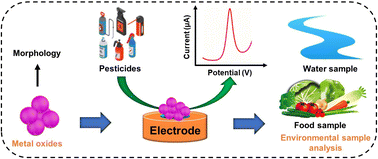Metal oxide-based electrochemical sensors for pesticide detection in water and food samples: a review
Abstract
The increasing need for food and agricultural resources necessitates using pesticides to protect plants, but this approach also poses pesticide poisoning and environmental hazards. Although designing an effective pesticide detection method is challenging, various technologies collaborate to develop an effective electrochemical sensor for detection of various pesticides. This review article examines the various metal oxides, their synthesis techniques, and their applications in electrochemical sensors, particularly for environmental applications, to detect pesticides in a variety of contaminated environmental samples. Metal oxides have unique properties that make them useful for pesticide detection because of their more active sites and electrical, optical, and semiconducting properties. Samarium molybdate-based electrode materials are considered the most promising direction for the development of electrode materials for pesticide sensors due to their economy, chemical stability, multiple valences, low detection limit, high sensitivity, and high electrocatalytic activity performance. In addition, this study investigates the current research trend in the detection of pesticides using metal oxide-based sensors in environmental samples, and researchers should expect new research perspectives and ideas. Overall, the metal oxide-based pesticide detection sensors will surely aid in meeting the growing demands for food and environmental monitoring and protection.

- This article is part of the themed collections: 2025 REV Collection from Environmental Science: Advances , Environmental Science Advances Recent Review Articles, Outstanding Papers of 2024 from RSC’s Environmental Science journals, Outstanding Papers 2024 – Environmental Science: Advances, Protecting Our Water Collection and Methods for Early Warning of Chemicals of Emerging Concern


 Please wait while we load your content...
Please wait while we load your content...